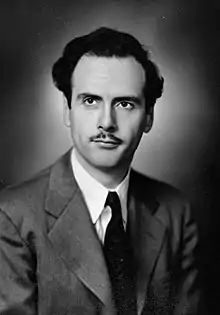University of St. Michael's College
The University of St. Michael's College is a college of the University of Toronto, founded in 1852 by the Congregation of St. Basil of Annonay, France. While mainly an undergraduate college for liberal arts and sciences, St. Michael's retains its Roman Catholic affiliation through its postgraduate theology faculty.
 | |
| Motto | Ευσέβεια μουσική γυμναστική |
|---|---|
Motto in English | Goodness, Discipline, Knowledge |
| Type | Federated college of the University of Toronto (1910– present) |
| Established | 15 September 1852 |
Religious affiliation | Roman Catholic Church |
Academic affiliation | AUCC, TST |
| Endowment | $30.2 million[1] |
| Chancellor | Thomas Christopher Collins |
| President | David Sylvester |
| Principal | Randy Boyagoda |
| Undergraduates | 4,603[2] |
| Postgraduates | 245 |
| Location | , , |
| Campus | Urban |
| Colours | Blue and yellow. Later, green was added. |
| Nickname | Bulldogs, Bay Street Fighting Irish (Historical)," Notre Dame of the North" (Historical) |
| Website | stmikes |
St. Michael's is most closely associated with teaching and research in the humanities and in theology. It is also known for being home to Marshall McLuhan throughout his influential career as a philosopher and communication theorist, from 1946 until his death in 1980. The Pontifical Institute of Mediaeval Studies resides within the college. St. Michael's College School is an affiliated boys school which was once the high school section of the college.
History
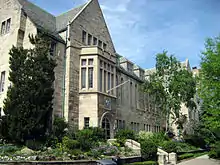
St. Michael's College was founded in 1852 as a Basilian college by Pierre Tourvieille, Superior General of the Congregation of St. Basil of Annonay, France.[3] The following year, it merged with St. Mary's Lesser Seminary under the unified control of the Basilian Fathers, whose establishment in Canada began with Bishop Armand-François-Marie de Charbonnel.[4] St. Michael's College educated pupils at three levels, operating as a preparatory school, as a liberal arts college, and as a minor seminary. The Basilians received a large estate in 1853 from John Elmsley, son of the Chief Justice of Upper Canada and a prominent philanthropist. St. Michael's College relocated to the new site east of the University of Toronto, and established the college parish, St. Basil's Church. The incorporation of the college was granted Royal Assent in 1855.
In the late 19th century when universities were closed to new Irish immigrants and many Canadians of Irish descent, St Michael's was seen as the only viable option and thus the school became a traditionally Irish filled college. Ever since this time St Michael's has been a bastion for higher education and a beacon for the Irish-Canadian community in Toronto and southern Ontario, with others coming from all over the rest of Canada to attend the dominantly Irish school.
By withdrawing its financial support in 1868, the provincial government encouraged denominational colleges to seek closer relations with secular institutions. St. Michael's affiliated with the University of Toronto in 1883, having secured a guarantee that it would conduct its own teaching in philosophy and history.[3] The university senate authorized St. Michael's to administer its own examinations in philosophy. On December 8, 1910, St. Michael's College became a federated college of the University of Toronto. The college maintained autonomy in faculty hiring and teaching in liberal arts subjects, while the University of Toronto governed examinations and the granting of degrees in all subjects except theology.[5] In 1912, Sir Robert Falconer, president of the University of Toronto, recognized the wish of St. Joseph's College and Loretto College to affiliate with the university. St. Joseph's and Loretto both became colleges of St. Michael's College, thereby allowing their female students to receive University of Toronto degrees.
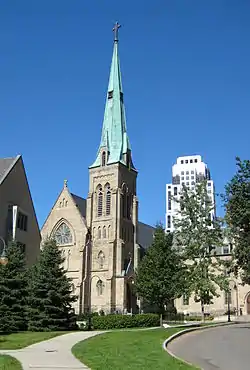
As the 20th century began, professional education expanded beyond the traditional fields of theology, law and medicine. Graduate training based on the German-inspired American model of specialized course work and the completion of a research thesis was introduced.[5] With the opening of the Institute of Mediaeval Studies in 1929, St Michael's expanded further into graduate teaching and research. Ten years later, Pope Pius XII signed a papal charter creating the Pontifical Institute of Mediaeval Studies.[6]
The preparatory school division of the college was reorganized in 1950 as St. Michael's College School, an independent private school, ending the college's direct governance while maintaining its affiliation. In 1952, the last lectures for women were held at Loretto and St. Joseph's Colleges, which became residential units of the college. Thereafter, all teaching was conducted coeducationally in the classrooms of St. Michael's College.

Throughout much of its history, St. Michael's benefited from a common practice whereby staff and faculty who were members of religious orders would donate their salaries back to the college. This source of income gradually disappeared as new faculty members were hired with mainly secular backgrounds, compelling the college to seek new revenue. The college's first modern fundraising attempt was launched in 1927, but was only partly successful due to the onset of the Great Depression. The Basilian Fathers of St. Michael's College was registered as a charitable organization in 1972.[7] Subsequent campaigns and land sales allowed the college to gradually increase its endowment, expand its academic programs and construct new residence buildings. The Canadian Catholic Bioethics Institute became affiliated with St. Michael's College in 2001. In 2002, the college marked the sesquicentennial of its founding with an anniversary mass held in St. Basil's Church.
Campus and buildings

The oldest buildings of St. Michael's College were constructed on the original Clover Hill estate donated by John Elmsley, and were designed by noted Scottish architect William Hay. With subsequent land acquisitions in 1890, 1920, 1926 and 1928, the college expanded from Clover Hill westward to reach Queen's Park. The present grounds of St. Michael's College form the eastern end of the University of Toronto campus, with Victoria College to the north and Regis College to the south. The main quadrangle of St. Michael's College is in the northwestern section of the college grounds, with its northern side leading into Victoria College.
The cornerstone was laid at Clover Hill on September 16, 1855, for the college building and the college parish of St. Basil's Church, which was consecrated November 16, 1856. This building is the oldest building at the University of Toronto in continuous academic use. A further addition, designed by William Irving, was constructed between 1872 and 1873 to house an auditorium, classrooms and student residence. In 1996, the original building was completely renovated by Carlos Ott Partnership Architects and renamed Odette Hall, and a modern religious art gallery donated by Rev. Daniel Donovan was installed on the two lower floors. Several Victorian homes on the former Elmsley estate survive as student residences at the St Michael's campus.

The master plan and Collegiate Gothic complex of buildings at the western side of the college nearest to Queen's Park were built in 1935 and designed by architect Arthur William Holmes in Gothic revival style: the Pontifical Institute, More House, Fisher House, Brennan Hall (1938) and Teefy Hall (1935-6) and extension of the East Wing, (1902–03). Brennan Hall in the north-central section of campus contains a dining hall, faculty dining room, common rooms, and guestrooms.[8]
Fisher House and More House both began as residences for men, while classrooms and faculty offices were located in Teefy Hall to the south. The Queen's Park Building to the north was built for the Pontifical Institute of Mediaeval Studies. A student-faculty centre was built in 1968 as an extension of Brennan Hall.
The Soldier's Memorial Slype connects the college quadrangle with Queen's Park, its sandstone walls etched with the names of St. Michael's College alumni who died in the World Wars and the Korean War.[9]
Examples of early post-war architecture at the college include Carr Hall, designed by Ernest Cormier and built in 1954, housing faculty and administrative offices, classrooms and an auditorium. At the northern edge of campus, Elmsley Hall was built in 1955 as a men's residence and a new residence for the Loretto College was built in 1958. The brutalist concrete building of the John M. Kelly Library was opened in 1969, at the southern portion of the college on St. Joseph Street. The former Ontario Research Council building next to the library has been redesigned with classrooms and offices as the Muzzo Family Alumni Hall.
Academics
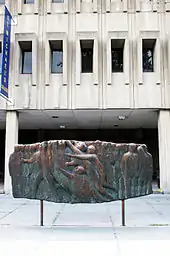
The University of St. Michael's College comprises the Faculty of Theology, the Division of Continuing Education, and its namesake undergraduate division, St Michael's College. Within the University of Toronto Faculty of Arts and Science, St. Michael's College sponsors the academic programs of book and media studies, Celtic studies, Christianity and Culture, Mediaeval studies and the Concurrent Teacher Religious Education Program. In 1996, the French and German departments of the University of Toronto took up residence on the St Michael's campus, followed in 2000 by the departments of Italian and Slavic studies.
After a reorganization in 1954, degrees in theology have been through the Faculty of Theology of St. Michael's College. In 1969, the Faculty of Theology became one of the founding colleges of the Toronto School of Theology, an ecumenical federation of the theological colleges at the University of Toronto.[10] The undergraduate division of St. Michael's College joined the undergraduate divisions of six other University of Toronto colleges in 1974 to reorganize its academic departments into the University of Toronto Faculty of Arts and Science.[5] In 2005, the Pontifical Institute of Mediaeval Studies ceased to be a division of the University of St. Michael's College and was reconstituted as an affiliated institution of U.S.M.C. instead.[11]

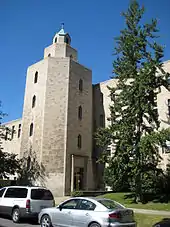
Marshall McLuhan was hired as a member of faculty at St. Michael's College in 1946, and taught English literature at the college until his death in 1980. During this time he became famous and influential for his books The Mechanical Bride (1951), The Gutenberg Galaxy (1962), and Understanding Media (1964), in addition to his oft-quoted aphorisms on communications and media such as "the medium is the message".
The John M. Kelly Library is the main library at St. Michael's College, and is part of the University of Toronto's mass digitization partnership with the Internet Archive. Although the library building was opened in 1969, the library collection dates back to the earliest days of the college. The collection has since been developed in support of undergraduate programmes in the Faculty of Arts and Science, graduate programmes in the Faculty of Theology, and programmes of the college's continuing education division. In addition to more than 300,000 bookform volumes, the library maintains subscriptions to almost 500 journals and magazines and has the largest suite of public computers on the east side of the University of Toronto campus.
The Kelly Library's collection has representation mainly in the areas of humanities and social sciences, particularly in book history, media studies, philosophy, Celtic history, languages and literature, Canadian history, English literature, and Medieval history. The theological collection emphasizes patristics, early and medieval church history, Thomism, the Bible (especially Canon, Johannine literature, and the history of criticism), liturgical renewal, religious education, and Catholic missions. There are also extensive archival special collections including substantial holdings of G. K. Chesterton, John Henry Newman, early printed books, and the papers of Henri Nouwen and Sheila Watson.
Residences and student life
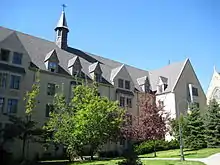
Within the secular environment of the University of Toronto, the Catholic traditions of St. Michael's are still evident in its college programs, fellows' interests, and student activities. Thus far, the college has largely avoided stirring controversy in its move toward coeducational residences.

Unlike the coeducational residences at other colleges of the university, male and female students at St. Michael's primarily reside on different floors of the residences, with currently only two mixed-gendered floors. Women students may choose to live at the single-sex Loretto College residence; men are permitted to visit Loretto during designated guest hours.
The dons at St. Michael's College are graduate, senior undergraduate and professional faculty students. The college's dining hall, the Canada Room, has recently been expanded and renovated and its hours have been extended.
Duane Rendle has served as the Dean of Students for over 20 years. More recently, the Dean of Students department has appointed Jennifer DuRoss as the Assistant Dean of Residence Life, and Emma Graham as the Assistant Dean of Student Life. Together, the Dean’s Office is responsible for residence operations, residence programming and all aspects of student life at St. Michael’s College.
The residences for St. Michael's students are Elmsley Hall Residence (Elmsley First, Mallon House, McBrady House, and Soulerin House), The Queen's Park Residence (Fisher House, More House, and Teefy House), the Historic Houses (formerly named as McCorkell House, Sullivan House, Gilson House, and Maritain House), and Sorbara Hall Residence (Lower Level, Murphy First (unofficial name), Second Floor, Fontbonne House, and Wall House).
Elmsley Hall was renovated in the summer of 2020, making it the most recently renovated space on campus. Renovations included painting and flooring in residence rooms, new furniture and updated common rooms on all floors.
Ice hockey at the college
St. Michael's College formerly participated in the senior ice hockey division of the Ontario Hockey Association, and won the J. Ross Robertson Cup in 1909 and 1910.[12]
The Toronto St. Michael's Majors in the Ontario Hockey League descended from the college's ice hockey team.
Notable people
Faculty
- Étienne Gilson, philosopher and historian
- Michael Lynch, professor of American literature and prominent gay activist
- Thomas Pangle, political theorist
- Jacques Maritain, philosopher
- Gregory Baum, theologian, peritus at Vatican II
- Marshall McLuhan, professor of English literature and prominent media critic
- Robert Birgeneau, 9th chancellor of the University of California, Berkeley, 14th president of the University of Toronto
- Mark Kingwell, philosopher and professor at the University of Toronto
- Kevin Sullivan, filmmaker
- Emoke Szathmary, 10th president of the University of Manitoba
- Walter Principe, CSB, First Dean of Theology, member of International Theological Commission
- Paul Weiler, professor of law at Harvard University
- Peter Galadza, Ukrainian-Greco Catholic priest, liturgist, and director of the Metropolitan Andrey Sheptytsky Institute of Eastern Christian Studies
- Margaret O'Gara, theologian and ecumenist
- Jean Vanier, L'Arche
Alumni
- Father David Bauer, Basilian priest, founder of the Canada men's national ice hockey team and inductee into the Hockey Hall of Fame[13]
- F. Anthony Comper, president and chief executive of the Bank of Montreal
- Rev. Charles Coughlin, noted 1930s anti-Semitic radio commentator and Fascist demagogue[14]
- Bonnie Crombie Mayor of Mississauga
- Paul Fromm, white supremacist and perennial political candidate[15]
- Colleen Hanycz, president of La Salle University
- Hugh Hood, author
- Laurier LaPierre, historian and former senator
- Paul Martin, 21st Prime Minister of Canada
- Daniel McCarthy, children's television producer who helped create The Friendly Giant, Mr. Dressup, and Sesame Park[16]
- Daniel James Sullivan, professor, author of An Introduction to Philosophy (1957), and recipient of Purple Heart[17]
- Peggy R. Williams, president of Ithaca College
Further reading
- Friedland, Martin L. The University of Toronto: A History. University of Toronto Press, 2002.
- Shook, Laurence K. Catholic Post-Secondary Education in English-Speaking Canada: A History. University of Toronto Press, 1971
- Slater, John G. Minerva's Aviary: Philosophy at Toronto. University of Toronto Press, 2005.
References
- "CAUBO 2006-2007 Financial Information of Universities and Colleges" (PDF). Canadian Association of University Business Officers. 2008.
- Liang, Xuelun (2018). University of Toronto Facts and Figures (PDF). Office of Planning & Budget. p. 33.
- St. Michael's College from Ontario Heritage Trust Archived July 16, 2011, at the Wayback Machine
- Pound, Richard W. (2005). Fitzhenry and Whiteside Book of Canadian Facts and Dates. Fitzhenry and Whiteside.
- University from The Canadian Encyclopedia, retrieved 16 January 2015
- "Image of the Historical Plaque outside of the Pontifical Institute of Mediaeval Studies".
- Charities Database from Canada Revenue Agency, retrieved 16 January 2015
- Arthur William Holmes from Biographical Dictionary of Architects in Canada 1800-1950, retrieved 16 January 2015
- "World Wars and Korean War memorial: St Michael's College: Memorial 35090-002 Toronto, ON". National Inventory of Canadian Military Memorials. Veterans Affairs Canada. Retrieved 30 December 2016.
- University of Toronto from The Canadian Encyclopedia, retrieved 16 January 2015
- University of St. Michael’s College Act, 2005, S.O. 2005 from ServiceOntario, 15 December 2005, retrieved January 2015
- "Senior Series". Ontario Hockey Association. 2019. Retrieved February 1, 2021.
- Oliver, Greg (2017). Father Bauer and the Great Experiment: The Genesis of Canadian Olympic Hockey. Toronto, Ontario: ECW Press. p. 46. ISBN 978-1-77041-249-1.
- "Charles E. Coughlin". www.ushmm.org. Retrieved 12 April 2018.
- Farber, Bernie and Prutschi, Manuel. "Paul Fromm" in From Marches to Modems: A Report on Organized Hate in Metro Toronto, Canadian Jewish Congress, 1997, pp. 16-26.
- "Friendly Giant producer Daniel McCarthy dies". CBC News. 2013-01-18. Retrieved 2013-02-02.
- Daniel James Sullivan from Geni.com, retrieved 16 January 2015
External links
| Wikimedia Commons has media related to University of St. Michael's College. |
